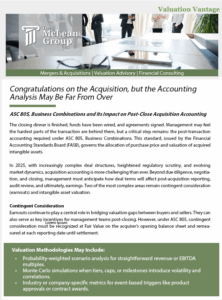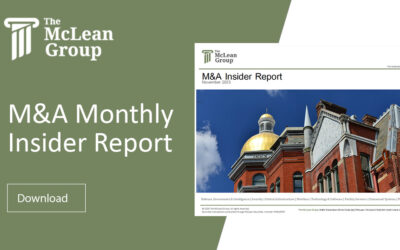Congratulations on the Acquisition, but the Accounting Analysis May Be Far From Over
 ASC 805, Business Combinations and Its Impact on Post-Close Acquisition Accounting
ASC 805, Business Combinations and Its Impact on Post-Close Acquisition Accounting
The closing dinner is finished, funds have been wired, and agreements signed. Management may feel the hardest parts of the transaction are behind them, but a critical step remains: the post-transaction accounting required under ASC 805, Business Combinations. This standard, issued by the Financial Accounting Standards Board (FASB), governs the allocation of purchase price and valuation of acquired intangible assets.
In 2025, with increasingly complex deal structures, heightened regulatory scrutiny, and evolving market dynamics, acquisition accounting is more challenging than ever. Beyond due diligence, negotiation, and closing, management must anticipate how deal terms will affect post-acquisition reporting, audit review, and ultimately, earnings. Two of the most complex areas remain contingent consideration (earnouts) and intangible asset valuation.
Contingent Consideration
Earnouts continue to play a central role in bridging valuation gaps between buyers and sellers. They can also serve as key incentives for management teams post-closing. However, under ASC 805, contingent consideration must be recognized at Fair Value on the acquirer’s opening balance sheet and remeasured at each reporting date until settlement.
The complexity lies in valuation. Earnouts today often involve multi-tiered structures, caps, or operational triggers tied to revenue, EBITDA, contract wins, or even regulatory approvals. Depending on structure, valuation methodologies may include:
- Probability-weighted scenario analysis for straightforward revenue or EBITDA multiples.
- Monte Carlo simulations when tiers, caps, or milestones introduce volatility and correlations.
- Industry or company-specific metrics for event-based triggers like product approvals or contract awards.
Each remeasurement can create income statement volatility, with decreases recognized as gains and increases as losses.
Intangible Asset Valuation
Another requirement of ASC 805 is the valuation and recognition of acquired intangible assets. In many cases, multiple intangibles — such as customer relationships, proprietary technology, or trade names — play interdependent roles in generating value. Separating and measuring these assets reliably can be challenging.
Traditional methodologies, such as the multi-period excess earnings method (MPEEM), remain common but must be carefully applied. Best-practice guidance, including that of The Appraisal Foundation, cautions against using two MPEEMs simultaneously. Instead, valuation professionals may employ alternative approaches such as:
- Relief-from-royalty
- Cost-to-recreate
- With-or-without
- Distributor method
Selecting the right approach requires balancing compliance, audit defensibility, and the economic reality of the business.
The Post-Transaction Impact in Todays Market
While deal teams may view closing as the finish line, post-transaction accounting under ASC 805 is often just as critical to success. Delays, audit challenges, or misapplied methodologies can erode value and distract leadership from integration.
Engaging experienced valuation specialists early — professionals who understand both the technical nuances of contingent consideration and the evolving landscape of intangible asset valuation — can help streamline audit reviews, reduce uncertainty, and allow management to stay focused on achieving post-close synergies.
Let’s Talk
Post-close accounting under ASC 805 is where value is tested, not just tallied. From purchase price allocation to contingent consideration remeasurement and intangible asset valuation, getting it right can reduce earnings volatility, streamline the audit, and keep leadership focused on integration.
If you have recently completed or are about to complete a transaction, or are advising a client who is, reach out to Ryan Berry or Scott Sievers to discuss how The McLean Group’s valuation and purchase price allocation services can help you with your purchase price allocation needs.
 ASC 805, Business Combinations and Its Impact on Post-Close Acquisition Accounting
ASC 805, Business Combinations and Its Impact on Post-Close Acquisition Accounting
The closing dinner is finished, funds have been wired, and agreements signed. Management may feel the hardest parts of the transaction are behind them, but a critical step remains: the post-transaction accounting required under ASC 805, Business Combinations. This standard, issued by the Financial Accounting Standards Board (FASB), governs the allocation of purchase price and valuation of acquired intangible assets.
In 2025, with increasingly complex deal structures, heightened regulatory scrutiny, and evolving market dynamics, acquisition accounting is more challenging than ever. Beyond due diligence, negotiation, and closing, management must anticipate how deal terms will affect post-acquisition reporting, audit review, and ultimately, earnings. Two of the most complex areas remain contingent consideration (earnouts) and intangible asset valuation.
Contingent Consideration
Earnouts continue to play a central role in bridging valuation gaps between buyers and sellers. They can also serve as key incentives for management teams post-closing. However, under ASC 805, contingent consideration must be recognized at Fair Value on the acquirer’s opening balance sheet and remeasured at each reporting date until settlement.
The complexity lies in valuation. Earnouts today often involve multi-tiered structures, caps, or operational triggers tied to revenue, EBITDA, contract wins, or even regulatory approvals. Depending on structure, valuation methodologies may include:
- Probability-weighted scenario analysis for straightforward revenue or EBITDA multiples.
- Monte Carlo simulations when tiers, caps, or milestones introduce volatility and correlations.
- Industry or company-specific metrics for event-based triggers like product approvals or contract awards.
Each remeasurement can create income statement volatility, with decreases recognized as gains and increases as losses.
Intangible Asset Valuation
Another requirement of ASC 805 is the valuation and recognition of acquired intangible assets. In many cases, multiple intangibles — such as customer relationships, proprietary technology, or trade names — play interdependent roles in generating value. Separating and measuring these assets reliably can be challenging.
Traditional methodologies, such as the multi-period excess earnings method (MPEEM), remain common but must be carefully applied. Best-practice guidance, including that of The Appraisal Foundation, cautions against using two MPEEMs simultaneously. Instead, valuation professionals may employ alternative approaches such as:
- Relief-from-royalty
- Cost-to-recreate
- With-or-without
- Distributor method
Selecting the right approach requires balancing compliance, audit defensibility, and the economic reality of the business.
The Post-Transaction Impact in Todays Market
While deal teams may view closing as the finish line, post-transaction accounting under ASC 805 is often just as critical to success. Delays, audit challenges, or misapplied methodologies can erode value and distract leadership from integration.
Engaging experienced valuation specialists early — professionals who understand both the technical nuances of contingent consideration and the evolving landscape of intangible asset valuation — can help streamline audit reviews, reduce uncertainty, and allow management to stay focused on achieving post-close synergies.
Let’s Talk
Post-close accounting under ASC 805 is where value is tested, not just tallied. From purchase price allocation to contingent consideration remeasurement and intangible asset valuation, getting it right can reduce earnings volatility, streamline the audit, and keep leadership focused on integration.
If you have recently completed or are about to complete a transaction, or are advising a client who is, reach out to Ryan Berry or Scott Sievers to discuss how The McLean Group’s valuation and purchase price allocation services can help you with your purchase price allocation needs.
ASC 805, Business Combinations and Its Impact on Post-Close Acquisition Accounting
The closing dinner is finished, funds have been wired, and agreements signed. Management may feel the hardest parts of the transaction are behind them, but a critical step remains: the post-transaction accounting required under ASC 805, Business Combinations. This standard, issued by the Financial Accounting Standards Board (FASB), governs the allocation of purchase price and valuation of acquired intangible assets.
In 2025, with increasingly complex deal structures, heightened regulatory scrutiny, and evolving market dynamics, acquisition accounting is more challenging than ever. Beyond due diligence, negotiation, and closing, management must anticipate how deal terms will affect post-acquisition reporting, audit review, and ultimately, earnings. Two of the most complex areas remain contingent consideration (earnouts) and intangible asset valuation.
Contingent Consideration
Earnouts continue to play a central role in bridging valuation gaps between buyers and sellers. They can also serve as key incentives for management teams post-closing. However, under ASC 805, contingent consideration must be recognized at Fair Value on the acquirer’s opening balance sheet and remeasured at each reporting date until settlement.
The complexity lies in valuation. Earnouts today often involve multi-tiered structures, caps, or operational triggers tied to revenue, EBITDA, contract wins, or even regulatory approvals. Depending on structure, valuation methodologies may include:
- Probability-weighted scenario analysis for straightforward revenue or EBITDA multiples.
- Monte Carlo simulations when tiers, caps, or milestones introduce volatility and correlations.
- Industry or company-specific metrics for event-based triggers like product approvals or contract awards.
Each remeasurement can create income statement volatility, with decreases recognized as gains and increases as losses.
Intangible Asset Valuation
Another requirement of ASC 805 is the valuation and recognition of acquired intangible assets. In many cases, multiple intangibles — such as customer relationships, proprietary technology, or trade names — play interdependent roles in generating value. Separating and measuring these assets reliably can be challenging.
Traditional methodologies, such as the multi-period excess earnings method (MPEEM), remain common but must be carefully applied. Best-practice guidance, including that of The Appraisal Foundation, cautions against using two MPEEMs simultaneously. Instead, valuation professionals may employ alternative approaches such as:
- Relief-from-royalty
- Cost-to-recreate
- With-or-without
- Distributor method
Selecting the right approach requires balancing compliance, audit defensibility, and the economic reality of the business.
The Post-Transaction Impact in Todays Market
While deal teams may view closing as the finish line, post-transaction accounting under ASC 805 is often just as critical to success. Delays, audit challenges, or misapplied methodologies can erode value and distract leadership from integration.
Engaging experienced valuation specialists early — professionals who understand both the technical nuances of contingent consideration and the evolving landscape of intangible asset valuation — can help streamline audit reviews, reduce uncertainty, and allow management to stay focused on achieving post-close synergies.
Let’s Talk
Post-close accounting under ASC 805 is where value is tested, not just tallied. From purchase price allocation to contingent consideration remeasurement and intangible asset valuation, getting it right can reduce earnings volatility, streamline the audit, and keep leadership focused on integration.
If you have recently completed or are about to complete a transaction, or are advising a client who is, reach out to Ryan Berry or Scott Sievers to discuss how The McLean Group’s valuation and purchase price allocation services can help you with your purchase price allocation needs.
About The McLean Group
For over 30 years, The McLean Group has been providing investment banking and financial services offerings focused on the Defense, Government & Intelligence (DGI), Security, Critical Infrastructure, Maritime, Facility Services, Unmanned Systems, and Public Safety markets. Our 60+ professionals bring deep industry experience and relentless execution to every client engagement. We provide solutions that blend financial creativity with operational expertise. Whether we are providing transaction advisory, valuation opinions, or growth capital, our services are unmatched in these core markets. Learn more at www.McLeanLLC.com.
RECENT NEWS
Josh Butler Promoted to Managing Director
McLean, Va. – Monday, January 5, 2026 – The McLean Group, a leading middle-market investment bank specializing in mergers and acquisitions, announced today the promotion of Josh Butler to Managing Director within the firm’s Defense, Government & Intelligence (DGI) Practice.
“Josh has consistently demonstrated exceptional judgment, leadership, and a deep commitment to client success,” said Mitch Martin, Managing Director at The McLean Group. “He has played a critical role in executing complex transactions and advising founders, investors, and management teams across the defense and government services ecosystem. Josh’s promotion reflects both his strong track record and the confidence our firm has in his continued leadership.” […]
McLean advised Rite Solutions in its transaction with Arcfield
The McLean Group advised Rite Solutions on its acquisition by Arcfield, a Veritas Capital portfolio company and leading government technology and mission support provider. The transaction brings together two highly complementary organizations, expanding Arcfield’s capabilities across critical national security mission areas while enabling Rite Solutions to scale its expertise in software development, systems engineering, and undersea warfare. The combination strengthens support for U.S. defense and intelligence customers amid increasing global security demands. […]
Monthly Middle Market M&A Insider Report (November 2025)
The McLean Group’s November 2025 M&A Insider Report highlights key developments shaping the Defense, Government & Intelligence, Security, Critical Infrastructure, Maritime, and Technology sectors. This month’s report features notable transactions involving industry leaders such as Thoma Bravo, Amphenol, Voyager Technologies, Markon, and Armada, underscoring sustained investor interest in defense modernization, cybersecurity, aerospace, and mission-critical technology platforms, even as market participants navigate the post-shutdown operating environment. […]










